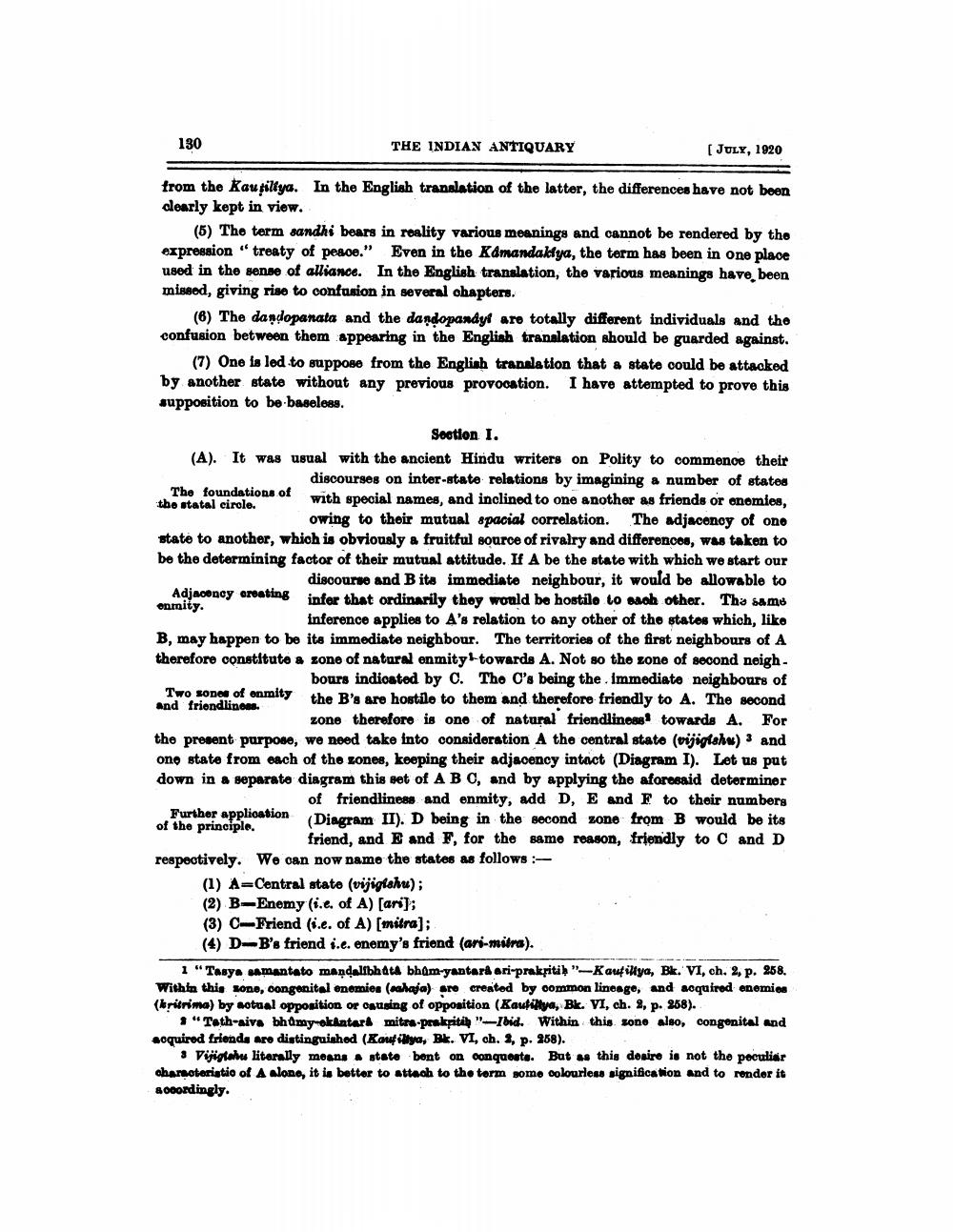________________
130
THE INDIAN ANTIQUARY
[JULY, 1920
from the Kaufiltya. In the English translation of the latter, the differences have not been clearly kept in view.
(5) The term sandhi bears in reality various meanings and cannot be rendered by the expression treaty of peace." Even in the Kamandaklya, the term has been in one place used in the sense of alliance. In the English translation, the various meanings have been missed, giving rise to confusion in several chapters.
(6) The dandopanata and the dandopandy are totally different individuals and the confusion between them appearing in the English tranalation should be guarded against.
(7) One is led to suppose from the English translation that a state could be attacked by another state without any previous provocation. I have attempted to prove this supposition to be baseless.
Section 1. (A). It was usual with the ancient Hindu writers on Polity to commence their
discourses on inter-state relations by imagining a number of states
of with special names, and inclined to one another as friends or enemies, the statal cirole.
owing to thoir mutual spacial correlation. The adjacenoy of ono state to another, which is obviously a fruitful source of rivalry and differences, was taken to be the determining factor of their mutual attitude. If A be the state with which we start our
discourse and Bits immediate neighbour, it would be allowable to Adjacency creating inter that ordinarily they would be hostilo to such other. Tha samo enmity.
inference applies to A's relation to any other of the states which, liko B, may happen to be its immediate neighbour. The territories of the first neighbours of A therefore constitute a zone of natural enmity towards A. Not so the zone of second neigh
bours indicated by C. The C's being the immediate neighbours of Two sons of onmity the B's are hostile to them and therefore friendly to A. The second and friendliness.
zone therefore is one of natural friendliness towards A. For the present parpose, we need take into consideration A the central state (vijigishu) and ono state from each of the zones, keeping their adjacency intact (Diagram I). Let us put down in a separate diagram this set of ABC, and by applying the aforesaid determiner
of friendliness and enmity, add D, E and F to their numbers of the principle. application (Diagram II). D being in the second zone from B would be its
friend, and E and F, for the same reason, friendly to and D respectively. We can now name the states as follows:
(1) A=Central state (vijiglahu); (2) B-Enemy (ie, of A) [ari]; (3) C-Friend (ie. of A) [mitra);
(4) D-B's friend i.e. enemy's friend (ari-mitra). 1 "Tasya samantato mandalibhata bhom-yantara ari-prakritib"-Kaufiliya, Bk. VI, ch. 2, p. 258. Within this sone, congenital enemies (sahaja) sre created by common lineage, and acquired enemies (eritrima) by actual opposition or causing of opposition (Kautilya, Bk. VI, ch. 2, p. 258).
1 "Tath-airs bhůmy-okAntark mitra-prakpitih "-Ibid. Within this sone aldo, congenital and soquirod friends are distinguished (Kauf illya, Dk. VI, ch. 2, p. 958).
Vijgtahu literally means a state bont on conqueste. But as this desire is not the peculiar characteristio of A alono, it is better to attach to the term somo colourless signification and to render it socordingly.




